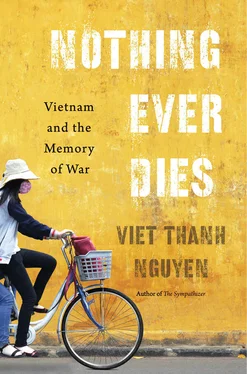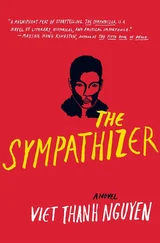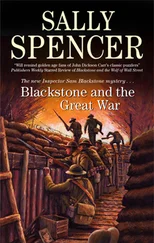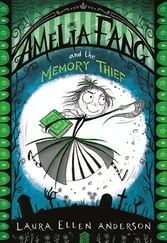None of this surprises, but I am not asking anyone to be surprised. I am not asking Hollywood or the industry of memory to do more or better. They do exactly what they are machined for, exerting dominance for profit and pleasure. I am only asking that their enactment of a joint venture with the war machine be recognized. If Baudrillard understood one thing clearly, it was that a film like Apocalypse Now was “cinematographic power equal and superior to that of the industrial and military complexes, equal or superior to that of the Pentagon and of governments.” 38Hollywood’s blockbuster strategy is only the cinematic equivalent of American military strategy, a celluloid campaign of shock and awe meant to obliterate all local competition, as American stealth bombers overwhelm enemy air defenses. Shock and awe was born out of the lessons of my war for young American field officers, who ultimately saw the war’s strategy of attrition and its escalation of violence as futile. Immediate, overwhelming force was needed to win wars, a lesson these officers, who became generals, applied against Panama, Grenada, and Iraq. Cinema-like technologies filtered shock and awe for the American public and the world, the vividly detailed and highly censored twenty-four — hour news feed that showed little of what happened to the enemy. As cinema conditioned audiences to see onscreen death and understand it as a simulation, so war now depended on audiences feeling that the death of others was neither real nor to be remembered. The industry of memory thus fulfilled its task of supporting the war machine by being its unofficial ministry of misinformation.
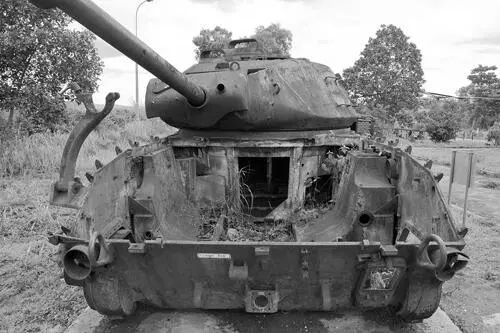
But industries are vulnerable to competition; war machines can be destroyed by asymmetric warfare; both can break down by falling victim to their own excesses of power, money, and greed. This is what one never learns in the war machine’s virtual reality world: total domination in industry and war can falter, especially when the others in the crosshairs fight back, oftentimes in unanticipated ways and from unanticipated directions.
THREE MILLION KOREANS DIED during the Korean War. Much of the country was laid waste by American bombing and by the attack and counterattack of armies from the north and the south, from the United States and from China, and from an array of states in the United Nations. 1While Cambodians remembered their genocide with the mantra of three years, eight months, twenty days — the finite duration of the Khmer Rouge regime — Koreans point out that their war never officially ended. Korea was divided into the Republic of Korea (the south) and the Democratic People’s Republic of Korea (the north), twins facing off for more than half a century in an ongoing Cold War drama. From the capitalist West’s perspective, contemporary South Korea is the success story of what capitalism can achieve. Perhaps it is hard to remember, then, that the country was so devastated by the war that in the 1960s it was poorer than South Vietnam. When the United States offered to pay South Korea to use its army in South Vietnam, the impoverished nation agreed. While some Americans call the Korean War the Forgotten War (forgetting that other Forgotten War in the Philippines), from the Korean perspective it is better to say that the Forgotten War was this one that Korea fought in Vietnam. In South Korea — which many simply call Korea — the Remembered War is the Korean War, which has assumed the status of a nation- and soul-defining event. In its shadow, the other Korean war in Vietnam is poorly remembered by Koreans, which only goes to show that amnesia and selective memory afflicts every nation.
Before I learned of the forgotten Korean war in Vietnam, I knew of Korea through its remembered Korean War. As an adolescent, I read Martin Russ’s The Last Parallel and watched American war propaganda, Rock Hudson starring in Battle Hymn and William Holden in The Bridges at Toko-Ri . Both actors played heroic Air Force pilots who helped save the country (the Air Force’s mass bombing of all of Korea was conveniently ignored). When I became vaguely aware of Korean students taking to the streets in political riots in the 1980s, Korea was simply another troubled foreign country that appeared briefly in American news broadcasts. During my college years, I along with many Americans had more pleasant encounters with Korea through its cuisine. But the full presence of Korean immigrants in the United States would arrive for the American public in 1991, with the Los Angeles riots, or uprisings, or rebellion. Koreatown was the unlucky star, Seoul USA, home to the largest Korean population outside of Korea and located in the midst of largely black and Latino neighborhoods. The unrest was provoked by two incidents: Los Angeles police officers beating a black man, their assault captured on video, and a Korean shopkeeper fatally shooting a black girl who had shoplifted a bottle of juice. Juries had acquitted both the officers and the shopkeeper. For many African Americans and Latinos, these injustices were the culmination of a history of oppression by the police and economic exploitation by ethnic outsiders. Korean and other shopkeepers became scapegoats for the poor and working class, and Koreatown burned. 2
A few years later, the reputation of Korea and Korean Americans began to change. Hyundai, Kia, LG, and Samsung stormed the ramparts of global capitalism. Millions of consumers owned a bit of Korea in their homes or their pockets, and some began driving Korean cars. Korean capital infused Koreatown and Los Angeles, and some immigrants who had left a poverty-stricken Korea to come to America in the 1960s suddenly found that their relatives in Korea had overtaken them. 3These immigrants had sacrificed their college degrees to become shopkeepers in ghettoes, all in the name of their American-born children, or so the narrative went in America’s model minority myth. In this myth, Asian immigrants and their American-born children appear as superhuman students and workers, with Koreans being the latest Asian immigrant population willing to discipline themselves and to sacrifice their bodies and minds to dream the American Dream. In doing so, they became the model for the rest of America’s “unsuccessful” minorities and immigrants, at least in the narratives of the media, the politicians, and the pundits who argue that those who fail to achieve the American Dream have only themselves and the welfare state to blame.
For many conservative commentators, this welfare state is a cousin to the socialist and communist states. The Asian American model minority was important in the antiwelfare narrative not only because of what it said about America domestically, but also because of how it proved to the rest of the world the worth of the American ethos of self-driven capitalist success. Capitalism American-style was imitated and improved upon most successfully by certain countries in Asia, including Korea. In a capitalist worldview, Korea’s Asian tiger economy was matched by the Korean diaspora in America as a model minority. Koreatown was not alone in its function as an ethnic enclave that stood in for a poor country. Most ethnic enclaves in the American imagination played that role, including Little Saigon. What made Koreatown unique was being put to the torch, at least in the late twentieth century (the earlier incinerations of ethnic enclaves at the hands of whites having largely been forgotten). In this capitalist way of thinking, the modern-day sacking of Koreatown by the ungrateful dark masses could be seen as another version of the burning of Korea by the communists. In both cases, lines were drawn to prevent the fires from spreading, by the Los Angeles Police Department in America and by the armed forces of the “free world” and the “free market” in Korea.
Читать дальше
